|
|
|
Sort Order |
|
|
|
Items / Page
|
|
|
|
|
|
|
| Srl | Item |
| 1 |
ID:
124167
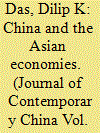

|
|
|
|
|
| Publication |
2013.
|
| Summary/Abstract |
The objective of this article is to explore the economic relationship between China and the surrounding dynamic Asian economies. It delves into China's influence over the Asian economies and whether this relationship has evolved in a market- and institution-led symbiotic manner. The three principal channels of regional integration analyzed in this article are trade, FDI and vertically integrated production networks. Another issue that this article explores is the so-called China 'threat' or 'fear' in Asia. The China threat implied that China was crowding out exports from the other Asian economies in the world market place. Also, as China became the most attractive FDI destination among developing countries, it was understood that China was receiving FDI at the expense of the Asian economies. These concerns were examined by several empirical studies and the inference was that they were exaggerated. The article concludes that China methodically expanded and deepened its economic ties with its regional neighbors. At the present juncture, China's integration with the surrounding Asian nations is deep. Both China and its dynamic Asian neighbors have benefited from this synergy.
|
|
|
|
|
|
|
|
|
|
|
|
|
|
|
|
| 2 |
ID:
088448
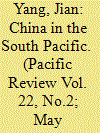

|
|
|
|
|
| Publication |
2009.
|
| Summary/Abstract |
China's influence in the South Pacific appears to be growing rapidly. Some analysts are concerned that China is on its way to replacing the West as the dominant power and China's rise in the region poses a major threat to the West. However, there is no clear evidence to suggest that China's deepening involvement in the South Pacific is a calculated strategic move for its military security. The move can be strategic mainly in the sense that it has strong implications for China's reunification strategy and it serves China's long-term development strategy. The strategic value of the South Pacific to China's national security is limited at present and will remain so in the foreseeable future. China also lacks the military capability to challenge the US-led West in the region in the years to come. Chinese influence in the region is not deep-rooted and is largely based on its 'no-strings-attached' aid and its increasing economic interactions with the region. China has serious image problems in the region and these problems are unlikely to be resolved in the near future. China thus has neither the hard power nor the soft power to become a genuine hegemon in the region.
|
|
|
|
|
|
|
|
|
|
|
|
|
|
|
|
| 3 |
ID:
160834
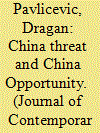

|
|
|
|
|
| Summary/Abstract |
Development of ‘16 + 1’ framework substantially depends on how Central and Eastern European countries understand their fast-evolving relationship with China. This article investigates and analyses related perceptions and discusses their implications for ‘16 + 1’. Focusing on the Sino-Serbian relationship, the study reveals that the understanding of China and its growing involvement in the region oscillates between the extremes, yet that both positive and negative evaluations are not supported by the available empirical evidence and informed by a proper understanding of the context within which the relationship takes place. This is likely to result in a sense of disillusionment, as well as heightened concerns about the relationship with China, casting shadow over the prospects of the China-CEE relations.
|
|
|
|
|
|
|
|
|
|
|
|
|
|
|
|
| 4 |
ID:
115612
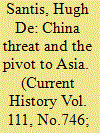

|
|
|
|
|
| Publication |
2012.
|
| Summary/Abstract |
America's expanding military footprint in Asia may be more of a provocation than a deterrent to China's aggressive behavior.
|
|
|
|
|
|
|
|
|
|
|
|
|
|
|
|
| 5 |
ID:
139314
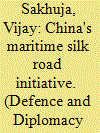

|
|
|
| 6 |
ID:
116620
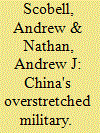

|
|
|
|
|
| Publication |
2012.
|
| Summary/Abstract |
Despite the dramatic growth of China's military power since the early 1990s, the Chinese People's Liberation Army (PLA), as all branches of China's armed forces are collectively known, remains overstretched as it seeks to address the wide range of missions it is called upon to perform. "China threat" theorists worry that the PLA poses a more significant challenge to the United States and China's neighbors than it did twenty years ago, and they are right. Yet the Chinese military is far from able to successfully carry out all its most pressing military tasks within China's borders and in its immediate neighborhood, and has only begun to project significant force beyond the Asia-Pacific.1 The real test for the PLA will be how adept it proves to be at bringing together new weapon systems, equipment, and formations in response to one or more serious instances of wartime or peacetime contingencies-a broad set of requirements the Chinese have dubbed "Diversified Military Tasks."2
|
|
|
|
|
|
|
|
|
|
|
|
|
|
|
|
| 7 |
ID:
096805
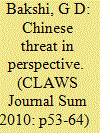

|
|
|
| 8 |
ID:
191115
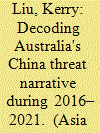

|
|
|
|
|
| Summary/Abstract |
Australia–China relations began to sour in 2016, and the China threat narrative began to dominate since then. Unlike previous studies which either use a qualitative approach or cross-sectional dataset for empirical analysis, this study creatively creates high-frequency weekly and monthly time series datasets using the Google Trends search results during January 2016–February 2021. Based on a series of time series modellings, this study examines the roles of various actors, including China's own policies, the Australian Strategic Policy Institute and Clive Hamilton, various factors, including Chinese purchase of Australian housing, Chinese investment in Australia, Chinese students in Australia and China's rise and various media outlets, including the Australian Broadcasting Corporation, Australian Financial Review, Sydney Morning Herald, Daily Telegraph and Herald Sun, in contributing to Australia's China threat narrative. This study makes significant contributions to academia in methods by bringing a new quantitative approach to international relations studies and to policy-makers as well by quantifying the roles of various actors, factors and media outlets in Australia's China policy debate.
|
|
|
|
|
|
|
|
|
|
|
|
|
|
|
|
| 9 |
ID:
181603


|
|
|
|
|
| Summary/Abstract |
While China’s rise may not trigger a Thucydides Trap with the United States, the possibility of conflict remains due to increasing tensions in the South China Sea and the ratcheting up of threats against Taiwan.
|
|
|
|
|
|
|
|
|
|
|
|
|
|
|
|
| 10 |
ID:
100253


|
|
|
| 11 |
ID:
116569
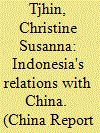

|
|
|
|
|
| Publication |
2012.
|
| Summary/Abstract |
This article looks into the recent development of Indonesia's relations with China. Notable progress can be seen in political and security relations, despite the fact that this dimension was at the core of their contentions during the 1970s and caused a freeze in diplomatic relations until the early 1990s. Economic relations, on the other hand, have long been the backbone of relations even before normalisation, but after Reformasi, economic relations have gradually been depicted as a new kind of threat even as they flourish. A unique factor contributing to this relationship is the distinctive role of Chinese Indonesians. This article also considers participation in multilateral diplomacy as an important aspect and strategy that affect bilateral relations. Under democracy, Indonesia is able to formulate a more productive and pragmatic China policy. However, since productive and pragmatic relations are not sufficiently strategic, Indonesia needs to formulate a long-term strategy to engage China and substantiate the so-called strategic partnership.
|
|
|
|
|
|
|
|
|
|
|
|
|
|
|
|
| 12 |
ID:
130616
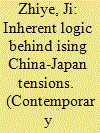

|
|
|
| 13 |
ID:
181600
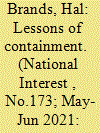

|
|
|
|
|
| Summary/Abstract |
Walter Lippmann was right that the Cold War would expose America to great evils. He was wrong to think that America could not, or should not, accept them as the price of avoiding even greater ones.
|
|
|
|
|
|
|
|
|
|
|
|
|
|
|
|
| 14 |
ID:
111675
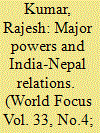

|
|
|
| 15 |
ID:
175841
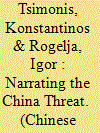

|
|
|
|
|
| Summary/Abstract |
This article unpacks the discursive construction of a European ‘China Threat’ narrative by European think tanks. We theorise think tanks as crucial actors in the securitising process, especially at the initial stages where ideas and reference frames are formed. Despite having no decision-making authority, think tanks participate as securitising actors in the process of idea formation and bidding, articulating a securitised frame of reference for policy makers. In the case of EU–China relations, we observe an emerging congruence between think tanks and policy makers that engage in a non-linear construction of a ‘China Threat’ policy frame. In this article, we review key think tank reports that are circulated through official EU policy channels and deconstruct the assumptions behind the ‘China Threat’ discourse. We first argue that, analytically, their securitising attempt is characterised by a distorted representation of Chinese economic activities abroad, including those falling under the Belt and Road Initiative. Second, politically, this narrative produces a distorted notion of European politics where pluralism is weakness and disagreement dissent, promoting a view of the EU where ‘responsible’ core countries must contain the periphery’s ‘opportunism’. Third, we contend that despite defending ‘Europeanness’ as the epitome of human rights and democracy, the securitisation of Chinese FDI rests on othering practices that risk undermining those very ideals. By identifying the problematic undertones of this securitising effort, we call for a fact-based and pluralistic debate on the challenges of Chinese investment and financing for European economies and societies.
|
|
|
|
|
|
|
|
|
|
|
|
|
|
|
|
| 16 |
ID:
097905
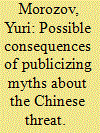

|
|
|
| 17 |
ID:
105219
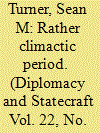

|
|
|
|
|
| Publication |
2011.
|
| Summary/Abstract |
From the late 1950s, American officials moved toward a proper appreciation of tensions in the Sino-Soviet alliance. However, prior to Autumn 1962 uncertainty remained in Washington over Beijing's willingness to break with the Kremlin in pursuit of its ideological objectives and national ambitions. This article demonstrates how the Sino-Indian border war in November 1962 and Beijing's response to the Cuban Missile Crisis shaped American understandings of the Sino-Soviet dispute and the China threat. Following developments in Autumn 1962 officials in the Kennedy Administration found cause to believe that China was not only the more militant of the two communist powers, but also that it was the more dangerous. This shift in threat perception had a significant impact on the US national security discourse, reinforcing the conviction of senior officials in Washington that the containment of China required a continued policy of non-engagement.
|
|
|
|
|
|
|
|
|
|
|
|
|
|
|
|
| 18 |
ID:
142085
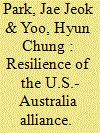

|
|
|
|
|
| Summary/Abstract |
Despite potentially significant differences between an American superpower’s and an Australian middle power’s global and regional interests and strategies, the U.S.- Australia alliance has remained resilient. Moreover, Australia has recently been very cooperative with the U.S. deployment of its military assets on Australian soil. What lies behind this intriguing set of circumstances in alliance relations? To address this question, this article begins by providing a historical overview to show that the U.S.- Australia alliance is resilient despite the lack of a mutually perceived threat. Then, this article criticizes the argument that the U.S.-Australia alliance continues because it is insurance against potential military threats, especially against potential Chinese threats. First, the likelihood of a “fundamental” attack on the Australian homeland is very slim. Moreover, the ANZUS accord lacks a formal mechanism that triggers an automatic U.S. involvement in the way that NATO’s Article Five mandates such a U.S. response in Europe. Second, currently the American and Australian threat perceptions regarding China vary. Canberra entertains less fear of a “rising China” than does Washington. Instead, this article provides order-centric rationales for retaining and strengthening the U.S.-Australia alliance, and in that context it analyzes the recent development of the alliance’s military aspects, including the deployment of U.S. Marines in Darwin on a rotational basis.
|
|
|
|
|
|
|
|
|
|
|
|
|
|
|
|
| 19 |
ID:
115949
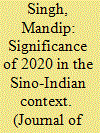

|
|
|
|
|
| Publication |
2013.
|
| Summary/Abstract |
The article looks at the implications of Hu Jintao's speech at the 18th Party Congress regarding the People's Liberation Army's (PLA) military modernization programme and analyses the significance of 2020 as a key timeline in the speech. Drawing from the previous biennial National Defense papers and significant statements of the Chinese leadership, it assesses the modernization plan of the PLA's four services in the Sino- Indian context and the probable capabilities that each service is likely will develop by 2020. The analysis covers the training, education, logistics and development of weapons and equipment by the PLA. This would enable Indian planners to assess the PLA capabilities and capacity as also temper own modernization plans to deter a possible China threat by 2020.
|
|
|
|
|
|
|
|
|
|
|
|
|
|
|
|
| 20 |
ID:
064498


|
|
|
|
|
|
|
|